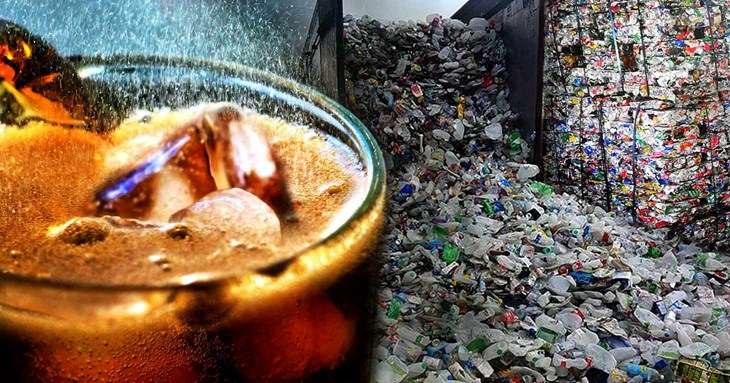Soft drinks and their containers with Denis the Dustcart
Published: 28 January 2021

In his regular feature, Denis the Dustcart talks about soft drinks, their containers and the impact they have on the environment.
You can follow Denis on his Facebook page to keep up with information about Recycling issues.
Single-use plastic continues to rank high on people’s lists of what to avoid, even through lockdown.
We may not be purchasing so many ‘on the go’ snacks and drinks, but supermarkets are still crammed with goods packaged in plastic – much of it hard to recycle.
One type of plastic packaging that is recyclable almost the world over is the bottle.
Take clear PET drinks bottles. These are good-enough quality to be turned back into clear drinks bottles, when they are sorted well enough – as they are here in Exeter.
Each person in the UK consumed on average over 210 litres of soft drinks in 2018. Of that, nearly 80 litres were carbonated drinks.
When we buy a soft drink in a plastic bottle, we take ownership of a plastic bottle. The smaller the bottle, the higher the ratio of plastic to drink we are purchasing; therefore, the more 500ml bottles of soft drink we buy ‘on the go’, the greater the ratio of plastic we bring into our lives.
Of course, this average consumption per person will be skewed somewhat by the daily consumption by many of energy drinks in aluminium cans. Aluminium is 100% and endlessly recyclable and is by far the most valuable material you can recycle, far outstripping plastic.
And we must do everything we can to recycle it, because bauxite mining is among the most destructive processes we perform in the effort to meet consumer demand for packaged goods.
In the UK, only 56% of aluminium was recycled in 2019. This is symptomatic of the ‘on the go’ consumer culture.
However, sales of fizzy drinks designed to be consumed while out and about are bound to have taken a hit in the last year. It will be interesting to see whether there has been any rise in the sale of soft drinks to be consumed at home.
Right now, we probably need a few luxuries here and there to help us through what is an extraordinarily difficult time. Ultimately, though, that is what sugary drinks are: a luxury.
And they feel like a luxury when we bring them into our homes. On the go, however, they have very much become an ‘everyday’ purchase.
As vital as it is that we recycle all our plastic drinks bottles and aluminium cans so that less new plastic and aluminium needs to be made, equally as important is that we try simply to buy fewer drinks.
I’m not suggesting we avoid them altogether. As I said, a ‘pick-me-up’ now and again can help us through times like we are all living through now. I’m really talking about the culture of consuming soft drinks like water when we’re out and about.
Part of the ‘new normal’, when restrictions lessen, has to be a reduction in consumption – in our expectation of what and how much we should be able to consume.
The only reason we should see a reduction in plastic bottle and aluminium can recycling is that people are buying fewer of them.
So that’s the packaging. But it isn’t just about the packaging.
In 2018, each person in the UK consumed on average over 210 litres of soft drinks.
Recycling plastic bottles and aluminium cans may, to a certain extent, counter the negative effects of producing new plastic and aluminium (and help to keep it out of the sea, where each will take around 500 years to break down), but, with so much emphasis placed on reducing single-use packaging, it’s easy to ignore the impact of what the packaging contains.
Soft drinks have a significant impact on our world, too – and not only with their carbon footprint.
Of the 210 litres of soft drink per person consumed on average in the UK two years ago, nearly 80 litres were carbonated drinks. Carbonated soft drinks are made from up to 94% water, but it can take 132 gallons of water to make just two-litres of sugary drink.
Water scarcity is already a major issue in developing countries where sugar cane for soft drinks is grown. These countries will feel the effects of climate change long before we do.
Then there’s the effect of pesticide use on the environment. The biodiversity loss associated with growing monocultures.
Processing sugarcane involves burning off the outer leaves. This affects air quality in the local environment and, of course, emits carbon.
Once the sugar syrup has been mixed with various chemicals and flavourings, it is combined with water for distribution.
It’s hard to calculate the emissions produced by transporting millions of litres of liquid around the world, due to the complexity and sheer size of the transport networks involved, but transporting ready-mixed drinks is going to have a significantly greater impact than transporting syrup or concentrate alone.
There is, however, a report on perhaps the most significant carbon emitter in the supply chain of soft drinks: refrigeration.
Refrigeration from the UK soft drink supply chain produces 1.5 million tonnes of CO2 per year, according to Defra.
92% of refrigeration emissions come from ‘retail and food service’, with vending machines and large fridges for soft drinks in supermarkets, shops and hotels being responsible for 67% of the total refrigeration carbon footprint of soft drinks.
Home refrigeration accounts for just 3%. This just goes to show how much ‘on the go’ consumption impacts our world.
Aside from the environmental and ecological issues presented by soft drink production, there is a human cost, too: millions of the smallholder farms relied upon by the drinks industry for sugar rarely make enough money from selling it to cover their costs in producing it.
There are many things we can do to limit our environmental and social impact in buying soft drinks.
We can think ‘drink’ before we head out and fill a bottle with squash or water.
We can buy Fairtrade, ethical brands. Fairtrade certification gives farmers a better deal, in turn promoting more sustainable practices.
We can avoid buying refrigerated soft drinks, perhaps only buying them when we are out and about on a hot day and then making sure we take the bottle home to recycle.
We can buy squash and other concentrates.
Or we can simply cut down, help our bodies and help our planet.
We mustn’t lose sight of the fact that sugary drinks are just that: a luxury.
Part of developing a ‘new normal’ is about re-evaluating what we expect to consume on an everyday basis.
